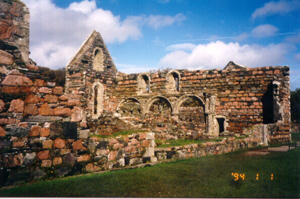
|
Recovery in the Thirteenth Century:The Augustinian CanonessesIona was also home, for a period, to a community of Augustinain canonesses. In 1200, the same Reginald son of Somerled, who had founded the abbey, also founded a house for women on the island.
The ruins of the nunery are the best preserved ruins of a female community
in Europe. Some of the historic disparity between men and women can
be seen from the fact that the women's community has never been restored.
Drawings from the 1760s show an already ruined nunery, and a clean-up
project was not initiated until 1874 by the 8th Duke of Argyll. Although
plans for a more complete restoration were complete in 1917, only the
north chapel and the cloister were repaired. The ruins are marked out
as those of a female community by the sheela-na-gig, a female
exhibitionist figure common in Ireland, found over one of the windows
facing the south.
The Cloister The wall surrounding the "nunnery" View of buildings from the north-east corner
|
 The house was dedicated to the Virgin Mary, and was founded by Reginald
son of Somerled, ruler of the Isles. In fact, the first prioress of
the cumminity was his sister Beatrice. It is very likely that these
first cannonesses came from Ireland, where Augustin communities were
plentiful. The last two prioresses were from the MacLean family and,
after the Reformation, the revenue from the coimmunity went to them.
The graveslab of Princess Ann MacLean was preserved in the chancel.
The house was dedicated to the Virgin Mary, and was founded by Reginald
son of Somerled, ruler of the Isles. In fact, the first prioress of
the cumminity was his sister Beatrice. It is very likely that these
first cannonesses came from Ireland, where Augustin communities were
plentiful. The last two prioresses were from the MacLean family and,
after the Reformation, the revenue from the coimmunity went to them.
The graveslab of Princess Ann MacLean was preserved in the chancel.